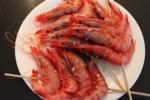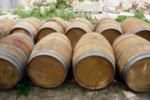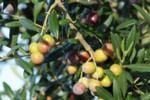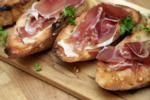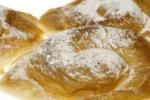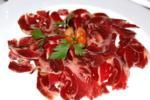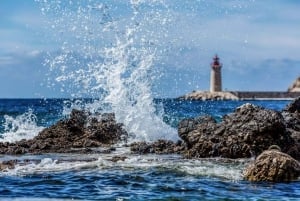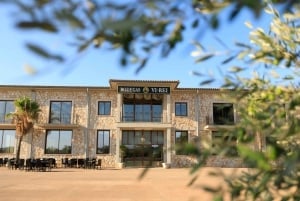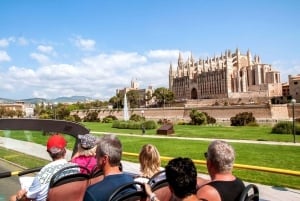Food & Drink in Mallorca
Mallorca has been at the crossroads of the Mediterranean for centuries, so local cooking is mainly a result of a fusion between foodstuffs that were available locally and the gastronomic heritage of those people who, for whatever reason, passed this way, such as the Romans, Arabs, Jews and Catalans - crossover at the crossroads!
The benign climate, bountiful sea and fertile soil has provided the island with a great variety of exquisite food products: embutits (sausage type products) such as sobrassada and botifarró, possibly the biggest emblem of all, the pastry ensaimada, liquors such as hierbas or palo, all types of conserves, almonds, honey and wines.
Mountain lands and terraces are filled with olive trees, one of the staples of Mallorcan cuisine. Seldom do you start a meal without a small bowl of olives and the exquisite olive oil is world renowned, as are the health properties of this staple. Mallorcan extra virgin olive oil is either fruity, when the olives are from the first picking, or sweet, made from the riper olives of the second harvest. Many olive trees in Mallorca are more than five hundred years old and those produce olives - and oil - that is more aromatic than those from younger trees.
Sobrassada is one of Mallorca’s most representative food products. The best quality meat from the pig is selected, chopped and mixed together with a generous amount of sweet paprika, cayenne pepper and salt. The mixture is then packed into selected and cleaned intestines, then hung up to dry. Once the moisture is lost, the mass blends together and both the flavour and the intensive red-orange colour become more apparent. To make sure that nothing is wasted from that wonderful animal, the pig, a whole variety of similar sausages or embutits has developed. Names you may see are arrissada, bisbe, botifarró, bufeta, camaiot, culana, and llonganissa.
The sea provides for the freshest of fish and seafood and some excellent recipes have developed in fishing folk households to make the best use of this produce. Some of the best seafood restaurants are located in and near traditional fishing ports and fresh fish is on sale daily at the major markets. There's plenty of choice, but if you like prawns, try the red version from Sóller.
The ensaimada is a circular cake created by coiled sweet pastry, made from flour, sugar, yeast, eggs and lard. It’s popularity both on and off the island is indisputable and there are many specialist bakeries, particularly in Ca'n Pastilla which is close to the airport. Spanish visitors from the mainland can be seen at the airport with their stacks of ensaimada boxes ready to take home.
As there are so many delicious looking breads and pastries available in the forns and panedarias, it is useful here to note a few so that you can choose whether you want sweet or savoury:
- Empanadas Small round pies usually available with either carné (meat), guisantes (peas), or atun (tuna). A bit like British pork pies.
- Coca de albaricogues, a sweet sponge cake made in the spring during the apricot season.
- Doblegats (folded). Half moon shaped puff pastry filled with cabello de angel (preserve made with strands of pumpkin in syrup), confectioner’s custard or chocolate. Folded to hold the filling.
There is no shortage of delicious chocolate filled pastries, like neapolitanas, chocolate croissants and biscuits such as palmeras (plain or chocolate coated), and estrellas (star shaped cookies coated with icing sugar). Your sweet tooth will know no bounds! If you have the opportunity, try the tarta manzana, Mallorca’s answer to the apple pie – simply delicious! Oh, and don't forget bunyols, a street snack of miniature doughnuts fried as you wait and served in a bag with added sugar to your taste.
The almond is part of both Mallorca’s landscape and its gastronomy. The almond groves scattered throughout the island are an absolute delight in January and February when they flower and attract thousands of visitors. When there is snow on the mountains, the effect can be stunning. The nuts, recognised as being among the best in the world, are used for both savoury and sweet purposes.
Hierbas (silent H so pronounced yairrbas) is made by marinating aromatic plants in alcohol for sixty days to give rise to a complex drink with a very distinctive mixture of aromas. It contains, among other herbs, fever grass, camomile, orange, lemongrass, rosemary, lemon balm and fennel, all collected in Mallorca. Available in dulces (sweet), seco (dry), or mixta (a combination), it’s a delicious way to finish your meal. On the other hand, Palo is a popular aperitif with ingredients that include cinchona bark and gentian root.
Pa amb oli. Simplest and most well known dish on the island, it is literally just bread with olive oil and salt. Pa amb oli I tomátiga is a slice of bread rubbed with half a tomato (traditionally ramellet), seasoned with salt, sprinkled with virgin olive oil and served with pickles typical of the island: pickled sea fennel, olives and capers. At restaurants you will find pa amb oli con jamon (serrano ham) or with queso (cheese) or a mixture of the two. Very reasonable, very filling, and normally very good.
Although it's not specifically Mallorcan, it's worth noting here the jamón serrano (the literal meaning is mountain ham, because the dry curing process is traditionally carried out at higher altitudes). Jamón Serrano is such a staple of Spanish culture - most households have a leg or a shoulder (paleta) in their kitchens and slice off it as and when required. Great in bocadillos (baguettes filled with ham and/or cheese, or tuna salad), or wonderful just served on a plate as a starter with some crunchy bread and olives. A much more expensive alternative is Jamón Iberico, produced from the black Iberian pig. The absolute top of the range is Jamón Iberico de Bellota.
It's likely that the Romans first introduced the cultivation of the grape vine to Mallorca, and wine has been made here ever since. Today, wine is produced all over the island and two areas - Binissalem and Pla i Llevant - have been awarded the Designation of Origin (D.O.) status. Many wineries (bodegas) allow visits and offer tours and tasting sessions, as well as encouragement to buy!
Salt has been harvested in Mallorca for at least 2000 years and the present harvest of around 15000 tons per year is almost entirely for local consumption. Natural sea salts are much more beneficial than the refined table salts we overuse! They contain minerals and marine trace elements which are stripped out in industrial processes and, in the case of Mallorca's natural salts, they are collected from largely pollution free environments. Apart from up market versions with trendy flavours added, such as Llum de Sal and Flor de Sal d'es Trenc, simply packaged salt collected from the island of Cabrera is also available in the south west of the island.
Some of the more common meals you will find included in the Menu del dia (menu of the day, normally includes two or three courses plus bread and water or wine) in the smaller more traditional bar cafes and at the excellent value-for-money buffet restaurants scattered across the island are:
- arros brut (a rice dish containing whatever happens to be in season)
- aguiat de peix (fish stew)
- most establishments will have their own version of soup
- also very traditional here on Mallorca is roast suckling pig (lechona asada)
- there are several speciality lamb restaurants (including one where the lamb is slow roasted in wood fires for eight hours, unbelievably tender).
And finally, no article on cuisine would be complete without mentioning paella which is one good reason for choosing Spain for your holiday. Many of the more rustic places will have this as their first course in their menu, particularly on a Sunday, and sometimes it is better not to ask what is in it although they are nearly always delicious! The more upmarket establishments serve a more tourist-friendly version – the choice is yours.
There is so much variety here in Mallorca you need never get bored and if you prefer to try the local cuisine during your stay here, we hope that this information will help you.


